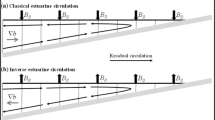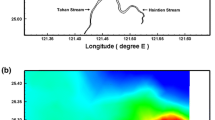Abstract
An observational study in the middle reach of Delaware Bay shows that vertical stratification is often enhanced during flood tide relative to ebb tide, contrary to the tidal variability predicted by the tidal straining mechanism. This tidal period variability was more pronounced during times of high river discharge when the tidally mean stratification was higher. This tidal variability in stratification is caused by two reinforcing processes. In the along-channel direction, the upstream advection of a salinity front at mid-depth causes an increase of the vertical stratification during the flood tide and a decrease during the ebb tide. In the cross-channel direction, the tilting of isohalines during the ebb reduces vertical stratification, and the subsequent readjustment of the salinity field during the flood enhances the water column stability. A diagnosis of the cross-channel momentum balance reveals that the lateral flows are driven by the interplay of Coriolis forcing and the cross-channel pressure gradient. During the flood tide, these two forces mostly reinforce each other, while the opposite occurs during the ebb tide. This sets up a lateral circulation that is clockwise (looking landward) during the first half of the flood and then reverses and remains counterclockwise during most of the ebb tide. Past maximum ebb, the cross-channel baroclinic term, overcomes Coriolis and reverses the lateral flows.















Similar content being viewed by others
References
Aristizábal M, Chant R (2013) A numerical study of salt fluxes in Delaware Bay estuary. J Phys Oceanogr 43(8):1572–1588
Banas NS, Hickey BM, MacCready P (2004) Dynamics of Willapa Bay, Washington: a highly unsteady, partially mixed estuary. J Phys Oceanogr 34:2413–2427
Beardsley RC, Boicourt WC (1981) On estuarine and continental shelf circulation in the Middle Atlantic Bight. MIT Press, Cambridge
Burchard H, Hofmeister R (2008) A dynamic equation for the potential energy anomaly for analyzing mixing and stratification in estuaries and coastal seas. Estuar Coast Shelf Sci 77:679–687
Chant RJ (2002) Secondary circulation in a region of flow curvature: relationship with tidal forcing and river discharge. J Geophys Res 107(C9):14–1–14–11
Chant RJ, Stoner AW (2001) Particle trapping in a stratified flood-dominated estuary. J Marine Res 59:29–51
Cheng P, Wilson RE, Chant RJ, Fugate DC, Flood RG (2009) Modeling influence of stratification on lateral circulation in a stratified estuary. J Phys Oceanogr 39:2324–2337
de Boer GJ, Pietrzak JD, Winterwerp JC (2008) Using the potential energy anomaly equation to investigate tidal straining and advection of stratification in a region of freshwater influence. Ocean Model 22:1–11
Garvine RW, McCarthy RK, Wong KC (1992) The axial salinity distribution in the Delaware estuary and its weak response to river discharge. Estuar Coast Shelf Sci 35:157–165
Geyer WR, Chant R, Houghton R Tidal and spring-neap variations in horizontal dispersion in a partially mixed estuary. J Geophys Res C 2008. doi:10.1029/2007JC004644
Jay DA, Smith JD (1990) Circulation, density distribution and neap-spring transitions in the Columbia River estuary. Prog Oceanogr 25(14):81–112
Lacy J, Stacey MT, Burau JR, Monismith SG (2003) Interaction of lateral baroclinic forcing and turbulence in an estuary. J Geophys Res 108(C3):34,1–34,15
Lerczak JA, Geyer WR (2004) Modeling the lateral circulation in straight, stratified estuaries. J Phys Oceanogr 34:1410
Li Y, LiM (2012) Wind-driven lateral circulation in a stratified estuary and its effects on the along-channel flow. J Geophys Res 117 (C9):C09005
MacCready P (2007) Estuarine adjustment. J Phys Oceanogr 37:2133–2145
MacCready P (2011) Calculating estuarine exchange flow using isohaline coordinates. J Phys Oceanogr 41:1116–1124
Nepf HM, Geyer WR (1996) Intratidal variations in stratification and mixing in the Hudson estuary. J Geophys Res 101(C5):12,079–12,086
Rippeth TP, Fisher NR, Simpson JH (2001) The cycle of turbulent dissipation in the presence of tidal straining. J Phys Oceanogr. 31:2458–2471
Scully ME, Geyer WR (2012) The role of advection, straining, and mixing on the tidal variability of estuarine stratification. J Phys Oceanogr 42:855–868
Scully ME, Geyer WR, Lerczak JA (2009) The influence of lateral advection on the residual estuarine circulation: a numerical modeling study of the Hudson River estuary. J Phys Oceanogr 39(1):107–124
Sharples J, Simpson J (1995) Semi-diurnal and longer period stability cycles in the Liverpool Bay region of freshwater influence. Cont Shelf Res 15(2/3):295–313
Sharples J, Simpson JH, Brubaker JM (1994) Observations and modelling of periodic stratification in the Upper York River estuary, Virginia. Estuar Coast Shelf Sci 38(3):301–312
Simpson J (1981) The shelf-sea fronts: implications of their existence and behaviour. Philos T R Soc Lond Series A 302:531–546
Simpson J, Bowers D (1981) Models of stratification and frontal movement in shelf seas. Deep-Sea Res 28(7):727–738
Simpson J, Hunter J (1974) Fronts in the Irish Sea. Nature 250:404–406. (August)
Simpson J, Hunter J (1978) Fronts on the continental shelf. J Geophys Res 83(C9):4607–4614
Simpson J, Brown J, Matthews J, Allen G (1990) Tidal straining, density currents and stirring in the control of estuarine stratification. Estuaries 13(2):125–132
Simpson JH, Souza AJ (1995) Semidiurnal switching of stratification in the region of freshwater influence of the Rhine. J Geophys Res 100(C4):7037–7044
Souza A, Simpson J (1996) The modification of tidal ellipses by stratification in the Rhine ROFI. Cont Shelf Res 16(8): 997–1007
Souza AJ, Simpson JH (1995) A two-dimensional (x-z) model of tidal straining in the Rhine ROFI. Cont Shelf Res 16(7):949–966
Stacey MT, Monismith SG, Burau JR (1999) Observations of turbulence in a partially stratified estuary. J Phys Oceanogr 29(8):1950–1970
USGS (2012) Delaware River at Trenton NJ
Wong KW (1994) On the nature of transverse variability in a coastal plain estuary. J Geophys Res 99:14,209–14,222
Acknowledgments
We thank Eli Hunter, Chip Haldeman, Joe Jurisa, Dove Guo, and the captain of the ship Ken Roma for all their dedication in collecting the data. This work was supported by a National Science Foundation grant OCE-0928567 and OCE-0825833. The author María Aristizábal was supported by a Dupont fellowship and the Institute of Marine and Coastal Sciences at Rutgers University. We also thank Jack McSweeney for closely reading the manuscript. We are also very thankful to the reviewers who insisted in the importance of the along-channel advection of stratification.
Author information
Authors and Affiliations
Corresponding author
Additional information
Responsible Editor: Rockwell Geyer
This article is part of the Topical Collection on Physics of Estuaries and Coastal Seas 2012
Rights and permissions
About this article
Cite this article
Aristizábal, M., Chant, R. Mechanisms driving stratification in Delaware Bay estuary. Ocean Dynamics 64, 1615–1629 (2014). https://doi.org/10.1007/s10236-014-0770-1
Received:
Accepted:
Published:
Issue Date:
DOI: https://doi.org/10.1007/s10236-014-0770-1




